Industrial bullshitters censor linguists
A bullshit lie detector company run by a charlatan has managed to semi-successfully censor a peer reviewed academic article. And I don't like it one bit. But first, some background, and then we'll get to the censorship stuff.
Five years ago I wrote a Language Log post entitled "BS conditional semantics and the Pinocchio effect" about the nonsense spouted by a lie detection company, Nemesysco. I was disturbed by the marketing literature of the company, which suggested a 98% success rate in detecting evil intent of airline passengers, and included crap like this:
The LVA uses a patented and unique technology to detect "Brain activity finger prints" using the voice as a "medium" to the brain and analyzes the complete emotional structure of your subject. Using wide range spectrum analysis and micro-changes in the speech waveform itself (not micro tremors!) we can learn about any anomaly in the brain activity, and furthermore, classify it accordingly. Stress ("fight or flight" paradigm) is only a small part of this emotional structure
The 98% figure, as I pointed out, and as Mark Liberman made even clearer in a follow up post, is meaningless. There is no type of lie detector in existence whose performance can reasonably be compared to the performance of finger printing. It is meaningless to talk about someone's "complete emotional structure", and there is no interesting sense in which any current technology can analyze it. It is not the case that looking at speech will provide information about "any anomaly in the brain activity": at most it will tell you about some anomalies. Oh, the delicious irony, a lie detector company that engages in wanton deception.
Read the rest of this entry »
 Irving John "Jack" Good, who died on April 5 at the age of 92, is best known to linguists as the author of a paper on mathematical ecology. The paper is I.J. Good, "
Irving John "Jack" Good, who died on April 5 at the age of 92, is best known to linguists as the author of a paper on mathematical ecology. The paper is I.J. Good, "